|
 Conchomyces bursiformis Conchomyces bursiformis
SynonymsHohenbuehelia bursiformis
Resupinatus sordulentus
Agaricus bursiformis
Agaricus euphyllus
Agaricus guilfoylei
Agaricus sordulentus
Pleurotus bursiformis
Pleurotus colensoi
Pleurotus dubius
Pleurotus euphyllus
Pleurotus guilfoylei
Pleurotus sordulentus
Stereum dubium
Agaricus tasmanicus
Pleurotus tasmanicus
BiostatusPresent in region - Indigenous. Non endemic
Images (click to enlarge)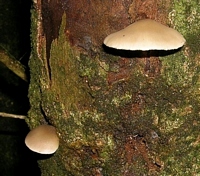
Owner: J.A. Cooper | 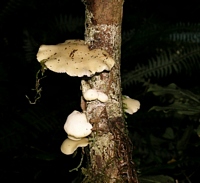
Caption: FUNNZ photo
Owner: J.A. Cooper | 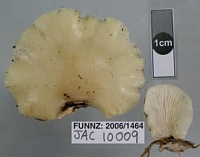
Caption: FUNNZ photo
Owner: J.A. Cooper | 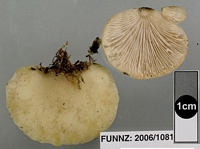
Caption: FUNNZ: 2006/1081, See public note for more information
Owner: FUNNZ | 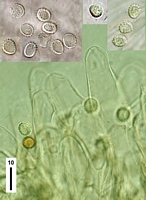
Caption: FUNNZ: 2006/1081, See public note for more information
Owner: FUNNZ | 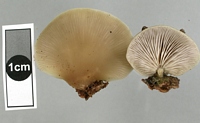
Owner: J.A. Cooper | 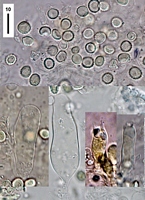
Caption: spores, cheilocystidia and basidia in Melzers.
Owner: J.A. Cooper | 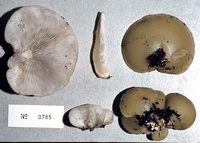
Caption: ZT0785
Owner: E. Horak: © Creative Commons Attribution-Noncommercial 3.0 New Zealand | 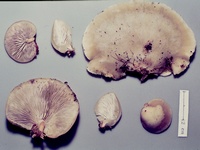
Caption: ZT67-230
Owner: E. Horak: © Creative Commons Attribution-Noncommercial 3.0 New Zealand | 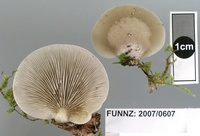
Owner: J.A. Cooper | 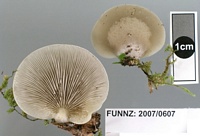
Caption: FUNNZ2007/0607
Owner: FUNNZ | 
Caption: Fig. 48 | |
Article: Stevenson, G. (1964). The Agaricales of New Zealand: V. Kew Bulletin 19(1): 1-59.
Description: Pileus 2-7 cm diam., sordid white with greenish tinge to pale ochraceous, orbicular to reniform, smooth to velvety; flesh concolorous, tough gelatinous at first, drying to papery texture. Gills adnexed, sordid white, deep, moderately crowded, rather thick at first but drying thin, margins somewhat irregular. Stipe up to 0.5 x 1 cm, lateral, pale ochraceous, finely fibrillose; or absent. Spores 8-11 x 6-9 µm, non-amyloid, thick-walled, with sharp or blunt spines (Fig. 48). Hymenophoral trama more or less regular of thin-walled hyphae up to 10 µm diam. Cystidia occasional on gill faces. Cuticle of loosely woven more or less regular thin-walled hyphae.
Habitat: On fallen timber, Levin, 22.5.1949, Stevenson; Keith George Park, Wellington, 30.5.1949, Stevenson; Lake Rotoiti, Nelson, 8.7.1949, A. Crawford; Waikanae, 27.7.1958,M. Davidson.
Notes: The different collections show considerable variation in the thickness of the spore-wall and the sharpness and the length of the spines. Pleurotus guilfoylei Berk., P. colensoi Berk. and P. scabriusculus Berk., the types of which have been examined at Kew, all have very similar spiny spores. More collections and studies of the fresh material are needed. The cystidia figured by Mr. D. A. Reid are occasionally present on the gill-faces in Lloyd's material, which was collected at Waikaremoana by H. Hill (no date), and also in some of the writer's collections, but they are not a striking feature of the gills as they are in the following genus.
Article: Massee, G.E. (1899) [1898]. The fungus flora of New Zealand. Transactions and Proceedings of the New Zealand Institute 31: 282–349 Wellington:.
Description: Pileus almost sessile or narrowed behind into a very short lateral stem-like base, horizontal or
the margin drooping, very convex; flesh thin, whitish, downy behind, becoming glabrous
towards the margin, 2-5 cm. across; gills slightly decurrent, transversely streaked, pallid;
spores dingy-white, subglobose, 6-7 µ, diameter.
Habitat: On dead bark.
Distribution: New Zealand. Tasmania.
Article: Horak, E. (1971). A contribution towards the revision of the Agaricales (Fungi) from New Zealand. New Zealand Journal of Botany 9(3): 403-462 (http://www.rsnz.org/publish/abstracts.php).
Notes: Pleurotus bursaeformis (Berkeley) (11,16) = Hohenbuehelia bursaeformis
(Berkeley) Reid, Kew Bull. 17: 304, 1963.
A detailed study of this polymorphic species which is widely distributed
throughout the Pacific basin, will be published at a later date.
Article: Massee, G.E. (1899) [1898]. The fungus flora of New Zealand. Transactions and Proceedings of the New Zealand Institute 31: 282–349 Wellington:.
Description: Solitary, or more or less imbricated. Pileus sessile, horizontal, thin, entirely white, rather soft,
almost or often quite even and glabrous, margin entire or slightly lobed, spreading, reniform
or semicircular, 3-6 cm. broad; gills radiating from the point of attachment, rather broad and
crowded, thin ; spores white, smooth, subglobose, 7-8 x 6 µ.
Habitat: On logs, &c.
Distribution: Dannevirke, Nelson, New Zealand.
Notes: Apparently a common species in New Zealand, having been sent on four different occasions
by Colenso ; also sent from Nelson by Dall. This species may possibly have been described
somewhere by Berkeley, but I have not been able to find the account. Distinguished by thin
substance and entirely white colour. Pleurotus guilfoylei somewhat resembles the present
species, but differs in having the pileus tomentose behind and the margin persistently
incurved.
Article: Horak, E. (1971). A contribution towards the revision of the Agaricales (Fungi) from New Zealand. New Zealand Journal of Botany 9(3): 403-462 (http://www.rsnz.org/publish/abstracts.php).
Notes: Pleurotus colensoi Berkeley apud Massee (16 D) = Hohenbuehelia bursaeformis
(Berkeley) Reid (see there).
Article: Horak, E. (1971). A contribution towards the revision of the Agaricales (Fungi) from New Zealand. New Zealand Journal of Botany 9(3): 403-462 (http://www.rsnz.org/publish/abstracts.php).
Notes: Pleurotus euphyllus Berkeley (9 D) = Hohenbuehelia bursaeformis (Berkeley)
Reid. Type material: SINCLAIR 1860.
This is another synonym of the common New Zealand species H. bursaeformis
(see there).
Article: Massee, G.E. (1899) [1898]. The fungus flora of New Zealand. Transactions and Proceedings of the New Zealand Institute 31: 282–349 Wellington:.
Description: Dimidiate or imbricated. Pileus sessile, attached laterally, horizontal, reniform, or
semiorbicular, entirely white, even, glabrous, margin incurved, sometimes lobed, tomentose
or downy behind near the point of attachment, 2-6 cm. across; gills rather broad and crowded,
thin, margin quite entire; spores narrowly elliptical, 7-8 x 3.5 µ.
Habitat: On logs, &c.
Distribution: Dannevirke, New Zealand. Australia.
Notes: Closely superficially resembling Pleurotus colerasoi, Berk., but sharply distinguished by the
narrowly elliptical, spores, also other minor characters. A specimen of this species, now in
Kew Herbarium, from Richmond River, Australia, was found growing " on the stem of a
living Areca monostachya."
Article: Horak, E. (1971). A contribution towards the revision of the Agaricales (Fungi) from New Zealand. New Zealand Journal of Botany 9(3): 403-462 (http://www.rsnz.org/publish/abstracts.php).
Notes: 131. X ? Pleurotus guilfoylei Berkeley (8, 16)
There is no material from New Zealand, but examination of the type revealed the
fact that Pl. guilfoylei must be considered a further synonym of Hohenbuehelia
bursaeformis (Berkeley) Reid (see also Pegler, 1965).
Article: Massee, G.E. (1899) [1898]. The fungus flora of New Zealand. Transactions and Proceedings of the New Zealand Institute 31: 282–349 Wellington:.
Description: Pileus horizontal, sessile and attached by, the edge or having a short stem-like point of
attachment springing from the posterior of the pileus, orbicular or somewhat reniform,
dingy-white, at first slightly hairy or strigose; becoming glabrous with age, margin incurved,
sometimes lobed, 3-6 cm. broad; gills radiating from the point of attachment, rather broad,
thin, ventricose, whitish; spores subglobose, minutely but distinctly warted, 7-8 µ, diameter.
Habitat: On wood.
Distribution: New Zealand. Queensland.
Notes: Resembling Crepidotus mollis in habit and general appearance, but distinguished by the
persistently white gills and spores. The warted spores stamp this species.
Article: Horak, E. (1971). A contribution towards the revision of the Agaricales (Fungi) from New Zealand. New Zealand Journal of Botany 9(3): 403-462 (http://www.rsnz.org/publish/abstracts.php).
Notes: Pleurotus sordulentus Berkeley and Broome (11,16,29) = Hohenbuehelia
brusaeformis (Berkeley) Reid. Examined material: COLENSO b 1230
Article: Watling, R.; Taylor, G.M. (1987). Observations on the Bolbitiaceae: 27. Preliminary account of the Bolbitiaceae of New Zealand. Bibliotheca Mycologica 117: 61 p. + 17 pl.
Notes: As Agaricus temulentus, Colenso b 751 Indicated by Horak (197ib) to lack all the essential features of the Bolbitiaceae. The basidiospores are 8-10 x 5-6 µm, kidney-shaped, smooth and honey-coloured in ammoniacal solutions. The cheilocystidia are diverticulate and pleurocystidia absent. There is controversy concerning the true identity of Ag. temulentus. Thus material in Kew collected at Glamis, Scotland by the Rev. J. Stevenson is Agrocybe arvalis (Fr.) Singer, yet material identified by M. C. Cooke and cited by Orton (in Dennis, Orton Si Hora, 1960) is in fact a member of the Tricholomataceae (see also Reid & Austwick, 1963).
Article: Massee, G.E. (1899) [1898]. The fungus flora of New Zealand. Transactions and Proceedings of the New Zealand Institute 31: 282–349 Wellington:.
Description: Pileus reniform or semicircular, horizontal, even, smooth, dingy-white or pallid, invested
with a gelatinous stratum, plane, or often depressed, and the margin acute and prominent, 1.5-4 cm. broad, produced behind
into a very short tomentose stem-like base, or sessile; flesh 3-4
mm. thick at the base, becoming thinner towards the margin, soft, white, flesh of stem or
point of attachment dingy; gills radiating from the point of attachment, rather broad, not
crowded, with numerous intermediate ones, dingy-white; spores globose, 4-5 µ diameter.
Habitat: On rotten wood.
Distribution: New Zealand. Tasmania, Australia.
Notes: Distinguished by the species having a gelatinous stratum on the pileus, and by the pallid or
dirty-white colour of every part. The pileus is often depressed or concave, and the gills
correspondingly convex at maturity.
Article: Horak, E. (1971). A contribution towards the revision of the Agaricales (Fungi) from New Zealand. New Zealand Journal of Botany 9(3): 403-462 (http://www.rsnz.org/publish/abstracts.php).
Notes: Pleurotus tasmanicus Berkeley (8,16) = Hohenbuehelia bursaeformis
(Berkeley) Reid.
Because of the subglobose, spiny or warted spores and the short, fusoid and
slightly thick-walled pleurocystidia this collection (COLENSO b 896) can
be identified as H. bursaeformis. This collection has nothing in common with
the type from Tasmania which is considered to be a synonym of Panellus
diversipes (Berkeley) Pegler 1965.
|